This is a collection of some of the pandemic memes for 2022. It’ll probably be my last meme post since the pandemic is more or less behind us.
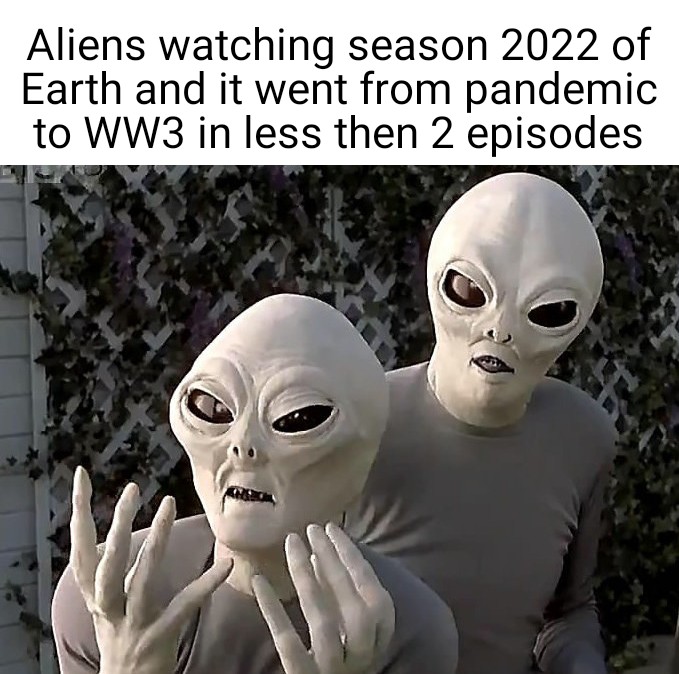
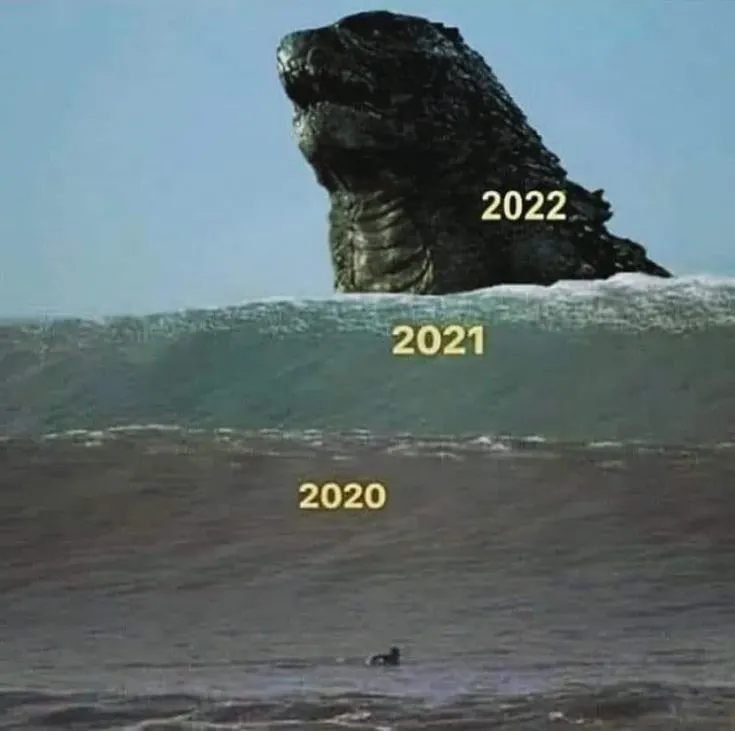


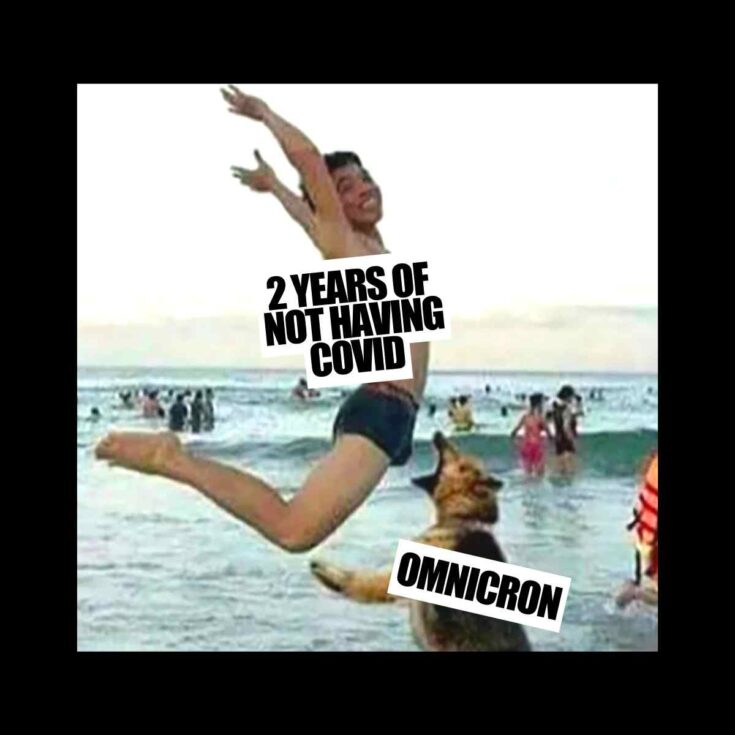
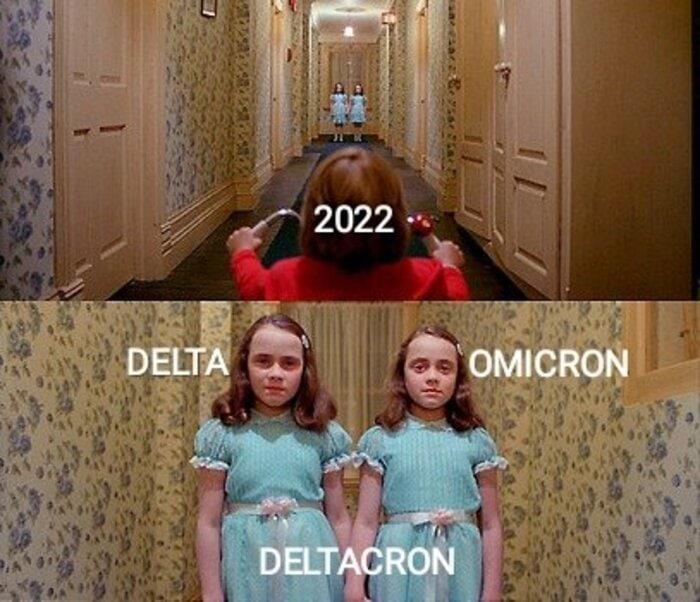
This is a collection of some of the pandemic memes for 2022. It’ll probably be my last meme post since the pandemic is more or less behind us.






This is my 100th post and there are still another 165 or so words and phrases to write about. Yes, there really were that many new terms that entered the pandemic vocabulary. This post is a bit different in that I’ve decided to post some of the popular pandemic memes from 2021.
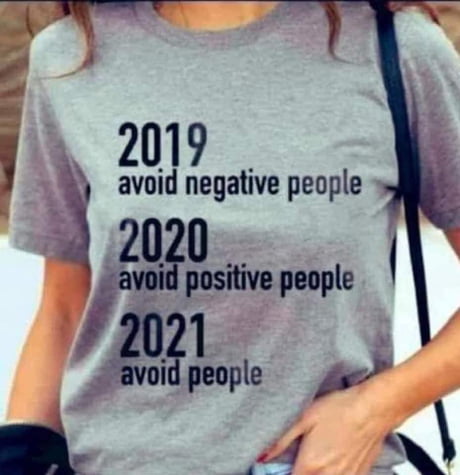
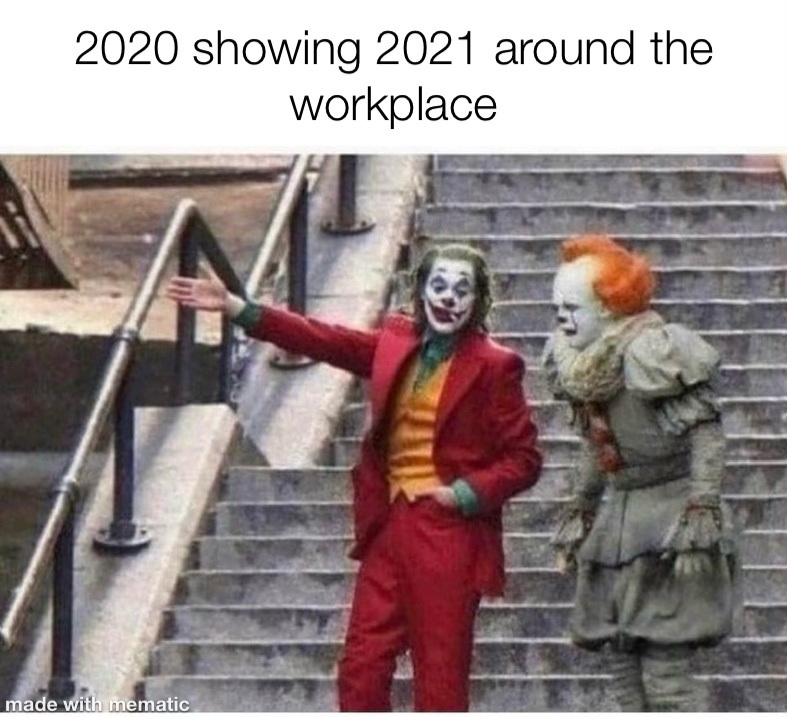
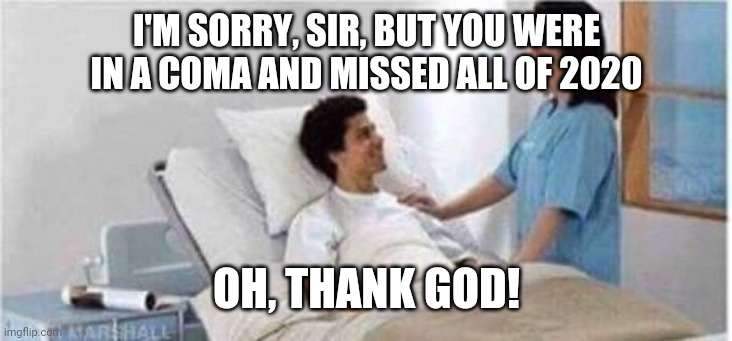

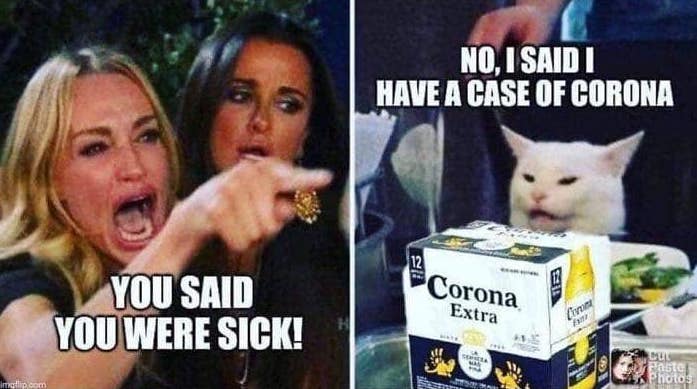
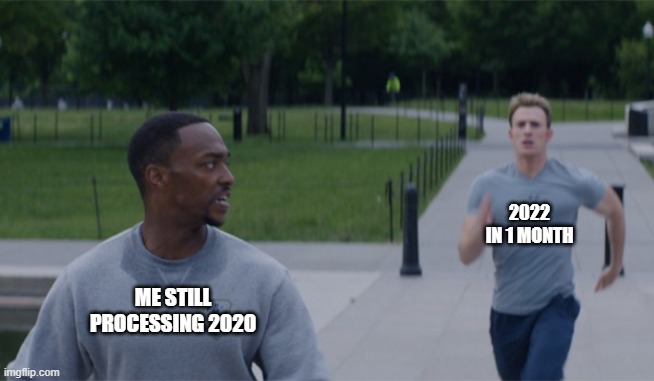
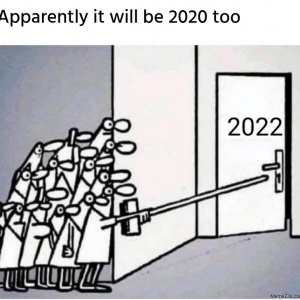
Many low paid essential employees receive “hero pay” during the pandemic and especially during periods of lockdown in appreciation for putting themselves at risk of catching Covid-19 whilst serving the public. Also known as “hazard pay,” many grocery store workers receive a couple of extra dollars per hour on top of their hourly pay. Most of these workers were already receiving less than minimum wage and so “hero pay” gave them a significant bump up in their wages. ShopRite, Stop & Shop, CVS, Amazon and other retail locations all gave their employees a bump in their hourly pay and most of these increase were instituted in March 2020.
Hero pay was sometimes referred to as Emergency Sick Pay and Compensation. On March 23, 2020 a Facebook post from ShopRite of Upper Deerfield in New Jersey said: “Our associates are going above and beyond in the face of the COVID-19 emergency. To show our support, we have implemented an Emergency Sick Pay and Compensation Program, that includes a $2 per hour increase in their wages at the following Bottino Supermarkets stores: ShopRite of Delsea-Vineland, ShopRite of Millville, ShopRite of Upper Deerfield and ShopRite of Washington Township.”
Recognizing that grocery store workers faced a much higher risk of infection and death from Covid-19 the United Food and Commercial Workers International Union which represents over 1.3 million workers announced an agreement with ShopRite that would give 50,000 union employees hazard pay across locations in Connecticut, New Jersey and New York:
The deal recognizes the ongoing risks ShopRite workers have faced as the COVID-19 pandemic continues, and provides retroactive hazard pay ahead of the holiday season that covers all hours worked between July 26 and August 22…UFCW confirmed this week that there have been at least 109 grocery worker deaths and over 48,000 grocery workers infected or exposed since the pandemic began.
UFCW International President Marc Perrone released the following statement: “Grocery workers have been on the frontlines since this pandemic began and continue to put themselves in harm’s way to help families put food on this Thanksgiving. This new UFCW agreement is a powerful victory for ShopRite grocery workers across New Jersey, New York, and Connecticut.”
UFCW
The extra money that these essential frontline workers enjoyed did not last. Once lockdown restrictions and mandates began to be lifted, grocery and retail stores ended hero pay. Radio station NJ1015 reported on July 15, 2020 that Stop & Shop was the latest grocery store to end “hero pay” for its employees. Many grocery stores extended this program through the months of April and May 2020:
Albertsons Companies, which owns Acme supermarkets, also offered a temporary $2 a hour increase for all non-union and union employees from March 20 to May 2.
Wegmans provided employees an additional $2 an hour at the height of the pandemic during the months of March, April and May.
As reported by the Philadelphia Inquirer, Whole Foods workers received an additional $2 an hour for as least some of the spring, but that program ended June 1.
ShopRite continues to provide store employees “temporary emergency premium pay” of $2 per hour, also instituted March 22 as the public health crisis first gripped the state.
“As non-essential businesses start to reopen, we have begun the process of transitioning to pre-COVID-19 wages. We will discontinue the emergency premium pay effective August 2,” according to Karen O’Shea, spokeswoman for ShopRite parent company Wakefern.
Vogt
The Today Show ran a segment discussing how thousands of grocery store and other retail workers will see their paychecks get smaller as hero pay comes to an end.
Some “hero pay” raises had unintended effects. Legislation passed in California which implemented $4 or $5 hourly raises for grocery workers caused some grocery stores to close their doors. On March 12, 2021 an article published on Reason.com said that “Kroger has announced that it will be closing three stores in Los Angeles as a result of the county’s new hazard pay law” (Britschgi).
We are grateful to all the heros who went to work at their own risk to provide us with the things we need.

Social Media Trends as of November 24, 2022
Facebook #heropay: people are posting about this
Instagram #heropay: 465 posts
TikTok #heropay: 50,900 views
Google Trends: “hero pay” first appeared during the end of March 2020 as grocery and retail stores started paying their workers hazard pay in appreciation and acknowledgement of the risks they took to provide the public with essential items and services.

Sources:
Britschgi, Christian. “‘Hero Pay’ Requirement for Grocery Workers Results in Unemployed Heroes.” Reason.com. March 12, 2021. URL: https://reason.com/2021/03/12/hero-pay-requirement-for-grocery-workers-results-in-unemployed-heroes/#:~:text=Berkeley%2C%20Oakland%2C%20and%20San%20Francisco,an%20hour%20during%20the%20pandemic.
Emergency Sick Pay and Compensation Program. ShopRite of Upper Deerfield (NJ). Facebook. 23 March 2020. URL: https://www.facebook.com/ShopRite.UpperDeerfield/photos/a.901182593305461/2856153904474977/?paipv=0&eav=AfZrvYte-JEfUZXtkLRvYv5G6wKFST96ONJc_whPgY2qSnIC4tAmLK4NBGKH9NypHLY&_rdr,
“Hero Pay” meme. MakeAMeme. URL: https://makeameme.org/meme/hes-probably-thinking-386813f91f.
Today channel. “Thousands Of Grocery Store Workers Are About To Lose ‘Hero’ Pay.” YouTube. 2020. URL: https://www.youtube.com/watch?v=cF60efCHps4.
“UFCW Announces COVID-19 Hazard Pay Deal for ShopRite Grocery Workers in New Jersey, New York, and Connecticut As Pandemic Continues.” United Food and Commercial Workers International Union. Nov 25, 2020. URL: https://www.ufcw.org/press-releases/ufcw-announces-covid-19-hazard-pay-deal-for-shoprite-grocery-workers-in-new-jersey-new-york-and-connecticut-as-pandemic-continues/.
Vogt, Erin. “Stop & Shop joins grocery stores ending ‘hero’ pay for workers.” NJ1015.com. July 15, 2020. URL: https://nj1015.com/stop-shop-joins-grocery-stores-ending-hero-pay-for-workers/?utm_source=tsmclip&utm_medium=referral.
The term “frontline worker” has been around for a long time. The Law Insider journal, a resource center for lawyers, defines frontline workers as “employees who directly produce goods or deliver services. In general they are eligible for overtime compensation, regardless of job title. Managers and Supervisors as defined below are not Frontline Workers.” The global pandemic and its associated lockdowns added to this definition.
In 2021 the New York Department of Labor published a document entitled “Characteristics of Frontline Essential Workers” which defined what a frontline worker is as well as their occupation:
The COVID-19 pandemic brought with it a host of pervasive words
New York Department of Labor
and phrases that suddenly had new meaning in our daily lives. One
example, “Essential Workforce”, became the ubiquitous catch-all for
workers who were forced to continue working during lockdowns. The
federal Centers for Disease Control defines “essential workers” as
“those who conduct a range of operations and services in industries
that are essential to ensure the continuity of critical functions in the
United States.” A subset of this group, the “Frontline Essential” workers, refers to those who perform critical work functions in close physical proximity to other people. “Frontline Essential” workers are at the greatest risk of exposure to COVID-19 as they perform their day-today job duties.
The report lists some of the occupations of frontline workers: Cashiers, Cooks, Fast Food and Counter Workers, Home Health and Personal Care Aides, Nursing Assistants, Police, Registered Nurses and
Teachers.
In June 2022 a group called The Front Line Singers consisting of a choir of frontline workers made up of nurses, teachers and paramedics, performed “an original song inspired by their struggles and team work during the coronavirus pandemic” on Britain’s Got Talent (Duke). The performance can be watched on the show’s YouTube channel here.
An article published on Chronicle Live quoted Simon Cowell praising the group for their performance: “What we’ve gone through the last few years, it’s surreal and then out of it comes moments like this. It gives us a chance to say thank you to people like you, because it’s people like you who protected all of us” (Duke).
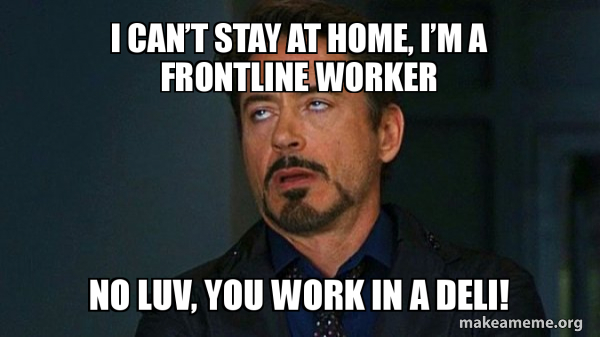
Social Media Trends as of November 23, 2022
Facebook #frontlineworker: 20,000 people are posting about this
TikTok #frontlineworker: 38,900,000 views
YouTube #frontlineworker: 328 videos and 205 channels
Google Trends: “frontline worker” first appeared as a small blip on the radar during the week of July 12, 2020. This is probably in response to people querying who qualified as a frontline worker. The popularity of the term peaked during the week of June 5, 2022 which just coincided with the The Front Line Singers performance on Britain’s Got Talent show.

Sources:
Britain’s Got Talent channel. “These frontline HEROES give MOVING performance! | Auditions | BGT 2022.” YouTube. May, 2022. URL: https://www.youtube.com/watch?v=RXDxiBwfjxc.
“CHARACTERISTICS OF FRONTLINE ESSENTIAL WORKERS IN NEW YORK STATE.” New York Department of Labor. Sep 2021. URL: https://dol.ny.gov/system/files/documents/2021/09/characteristics-of-frontline-workers-09-22-21.pdf.
Duke, Simon. ” Who are Front Line Singers on Britain’s Got Talent? Choir spark emotional reaction from judges.” Chronicle Live. 2 June 2022. URL: https://www.chroniclelive.co.uk/news/tv/who-the-frontline-singers-bgt-23894790.
“Frontline worker.” Law Insider. URL: https://www.lawinsider.com/dictionary/frontline-worker.
“I can’t stay home, I’m an frontline worker” meme. MakeAMeme.org. URL: https://makeameme.org/meme/i-cant-stay-a3d7eff2df.
The phrase “died suddenly” started to appear sometime after the first Covid-19 vaccines were administered when some of those who received the injections suffered a fatal adverse reaction to them – sometimes within hours of getting the shot. This is a controversial subject for obvious reasons but the phrase has appeared constantly in the news and on television. A cursory Google search containing the phrase “died suddenly” lists several news articles about the unexpected deaths of athletes, news presenters, doctors, teachers, students and even young children.
Died Suddenly is the name of a movie released by the Stew Peters Network on November 21, 2022. It explores the fatal adverse reactions to the Covid-19 vaccines and was produced by two award winning filmmakers, Matthew Skow and Nicholas Stumphauzer and can be watched for free here.
The official Twitter handle for Died Suddenly appears here.
The movie had mixed reviews with some calling it a conspiracy theory and others saying there is truth to what the movie portrays. One critical review published on Distractify.com says the movie is “anti-vaxx propaganda that tries to link real-life tragedies to the COVID-19 vaccine via baseless claims and erroneous information” (Cadorniga).
This blog reports on words and phrases that have entered our lexicon since the beginning of the pandemic and any creative content associated with these terms.
Social Media Trends as of November 22, 2022
Instagram #diedsuddenly: 2,668 posts
TikTok #diedsuddenly: 3,200,000 views
YouTube #diedsuddenly: less than 100 videos and channels
Google Trends: “died suddenly” has always been around because some people do die suddenly either in their sleep or whilst engaging in some activity. However, the popularity of the term spiked during the last week of October 2021 which was some months after the Covid-19 vaccine became available to the public. It peaked during the first week of November 2022 when the movie Died Suddenly was released.
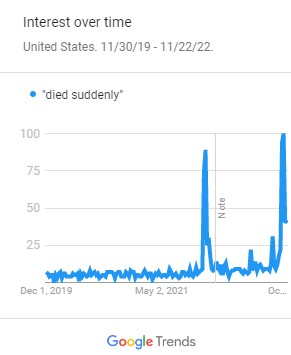
Sources:
Cadorniga, “The Anti-Vaxx Propaganda Film ‘Died Suddenly’ Is Streaming in the Weirdest Place.” Distractify. November 22, 2022. URL: https://www.distractify.com/p/where-to-watch-died-suddenly.
“Died Suddenly.” Twitter. November 21, 2022. URL: https://twitter.com/DiedSuddenly_.
The Stew Peters Network. “Died Suddenly.” Rumble.com. November 21, 2022. URL: https://rumble.com/v1wac7i-world-premier-died-suddenly.html.
Essential employees or essential workers are those who provide vital services such as nurses, doctors, police and firefighters to name a few professions. At the height of the pandemic, when lockdown restrictions were in effect, the pool of essential workers expanded to include grocery workers, transportation workers and teachers.
The Centers for Disease Control defines essential workers as “as those who conduct a range of operations and services in industries that are essential to ensure the continuity of critical functions in the United States (U.S.)” (CDC).
When lockdown restrictions were in effect, states had to balance protecting the public while keeping the critical parts of their economy open. Millions of office workers deemed “non essential employees” could work remotely while those who worked in vital industries such as health care, policing and teaching still had to show up to work although a majority of schools instituted virtual learning.
Some states had a confusing patchwork of overlapping categories of what was considered essential. The National Conference of State Legislatures pointed out that:
States have added and subtracted essential worker categories and sectors based on what makes the most sense for them. For example, in some states workers supporting religious organizations and churches are considered essential, while in some others workers who support the cannabis industry receive the essential designation. Between the federal guidelines and state essential worker orders, a number of major sectors overlap including, but not limited to energy, child care, water and wastewater, agriculture and food production, critical retail (i.e. grocery stores, hardware stores, mechanics), critical trades (construction workers, electricians, plumbers, etc.) and transportation.
NCSL
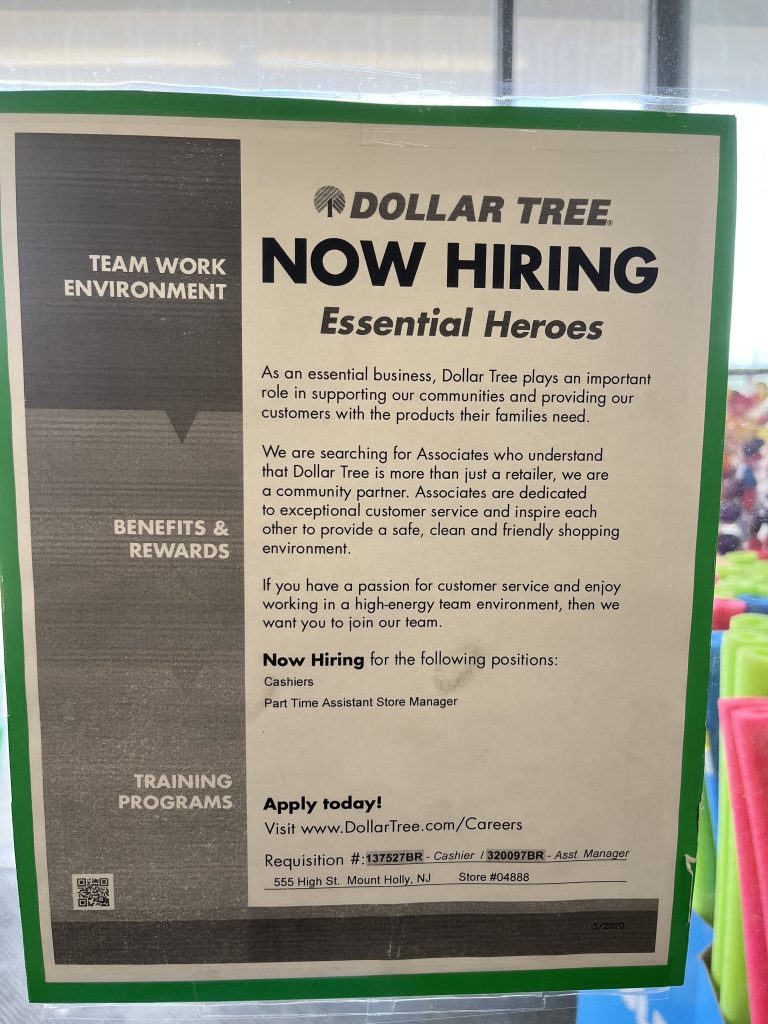
An article published for the Daily Iowan on July 28, 2020 said that custodians and janitorial workers were to be considered essential employees because work calls for them to maintain high standards of cleanliness and sanitation. It quotes Kelly Baker, a faculty member of the University of Iowa College of Public Health, who said “[these workers are] already practicing a lot of the behaviors that we would ask them to implement to protect them from infection, so for example the wearing of gloves and using disinfectant products to clean surfaces and wearing masks and maintaining as much distance and separation from raw biological fluids as possible” (Hartel).
In 2020 the French-American musician Mark Rebillet uploaded a tribute song for essential workers to YouTube called the “Essential Workers Anthem.” It has received almost 2 million views.
Although the pandemic is behind us, we will always remember the sacrifice that essential workers made, risking their lives to provide us with the things we need from healthcare to food and we are forever grateful to them.
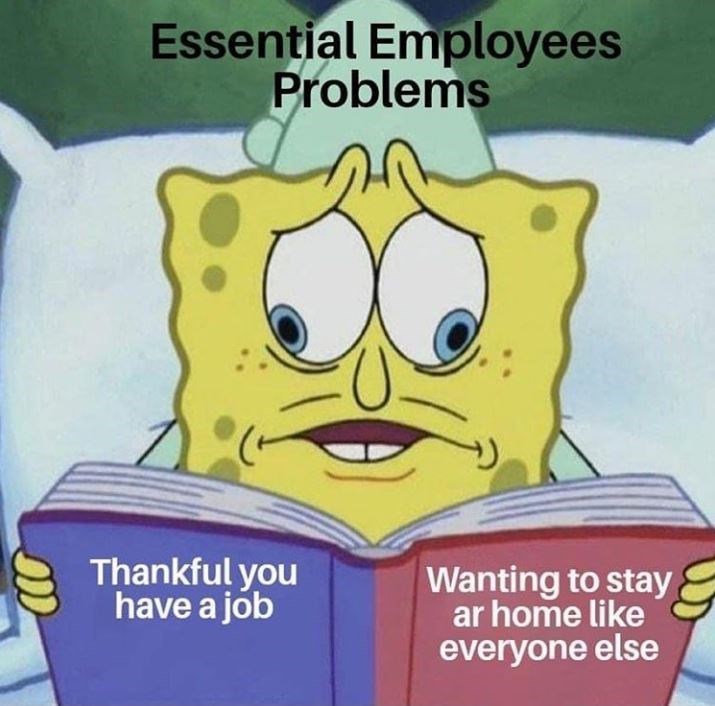
Social Media Trends as of November 20, 2022
Facebook #essentialemployee: 20,000 people are posting about this
Instagram #essentialemployee: 33,701 posts
TikTok #essentialemployee: 171,800,000 views
YouTube #essentialemployee: less than 100 videos and channels
Google Trends: “essential employee” first appeared during the week of March 15, 2020 and spiked a week later. No doubt individuals were searching Google to see if their jobs were considered essential or non-essential.
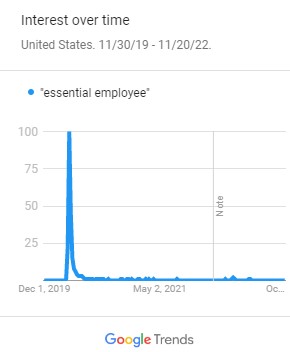
Sources:
“COVID-19: Essential Workers in the States.” National Conference of State Legislatures. January 11, 2021. URL: https://www.ncsl.org/research/labor-and-employment/covid-19-essential-workers-in-the-states.aspx#:~:text=All%20workers%20who%20are%20part,Infrastructure%20Security%20Agency%20(CISA).
Hartel, Mary. “Janitors and Custodians remain essential workers during COVID-19 pandemic.” Daily Iowan. July 28, 2020. URL: https://dailyiowan.com/2020/07/28/janitors-and-custodians-remain-essential-workers-during-covid-19/.
“Interim List of Categories of Essential Workers Mapped to Standardized Industry Codes and Titles.” Centers for Disease Control and Prevention. URL: https://www.cdc.gov/vaccines/covid-19/categories-essential-workers.html.
reeceecup527. “Essential Employees Problems” meme. Instagram. March 30, 2020. URL https://www.instagram.com/p/B-YL5bGJGsT/.
Rebillet, Mark. “ESSENTIAL WORKERS ANTHEM.” YouTube. 2020. URL: https://www.youtube.com/watch?v=GnDcD7rtaV4.
In the early days of the pandemic when mask mandates were required, people who chose not to comply were often confronted about it and “mask shamed” either in person or on social media. Of course, the reverse can also be true – now that the pandemic is more or less behind us and restrictions have been lifted, there are those who still choose to wear masks and they may be shamed or ridiculed for it because everything has gone back to normal.
The Macmillan Dictionary has an entry for mask shaming:
criticizing or confronting someone who is not wearing a face covering
As the country begins to open up, the mask shaming has moved from social media to in-person confrontations.
Mask shaming shows how quickly new behaviours can go from rare to common.
The Urban Dictionary also has an entry for this term:
When others treat you with disdain or contempt for (1) not wearing a mask in public or (2) wearing a medical grade mask that health care providers need.
I was mask shamed while lining up for groceries without a facial covering. The piercing stares and angry mumbles from those wearing masks left me feeling uncomfortable.
GD
Mask shaming regularly appeared in the news around the time that Covid restrictions were being instituted. An article published for NBC Bay Area News on May 7, 2020 reported that individuals were being publicly shamed for not wearing a mask: “’It happened to me the other day,’ said Oakland resident Katherine. ‘I went for a walk in the morning and someone came up to me and said ‘put on a mask!’ I felt bad” (McSweeney). Some feel that “mask shaming” is necessary to remind people that everyone is responsible for doing their part to prevent the spread of Covid-19 while others feel that shaming people simply adds tension to the situation.
The other kind of mask shaming – insulting those who continue to wear masks – has been an issue for people going back to the office. In April 2022 the Society for Human Resource Management journal published an article about mask shaming colleagues. It noted that “employers have observed an increasing lack of respect in the workplace, including so-called mask shaming—insulting colleagues who, out of concern over COVID-19, continue to wear masks” (Smith). The article quotes Katherine Dudley Helms, an attorney with Ogletree Deakins in Columbia, S.C. who says that “Many people have decided that, either having had COVID or receiving the vaccine, no further precautions are needed. However, there are others who for many reasons still choose to wear masks and clean their hands frequently. Employers should communicate to their employees the expectation that either choice is valid and should be respected.”
A CBS Sacramento news clip featured interviews with those who have been mask shamed for wearing or not wearing a mask:
Whether you agree with the mask mandates or not or you don’t like the fact people still choose to wear masks in public, you should respect their choice. Don’t mask shame them.
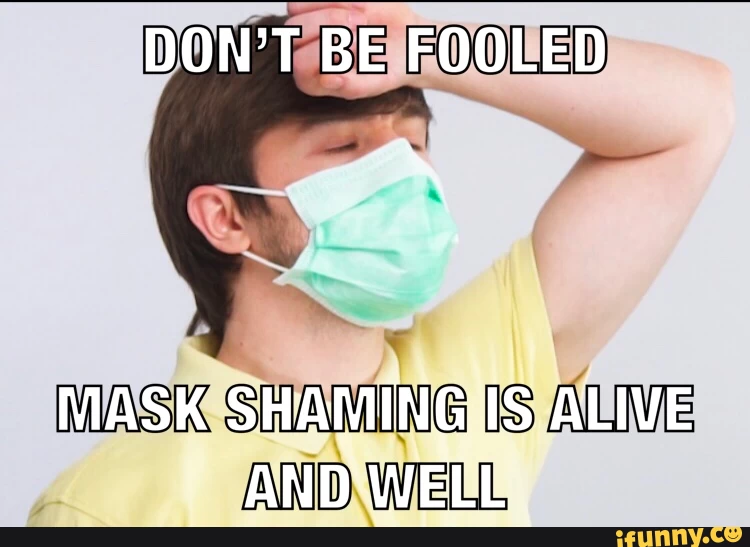
Social Media Trends as of November 12, 2022
Facebook #maskshaming: people are posting about this
Instagram #maskshaming: 1,181 posts
TikTok #maskshaming: 1.1 million views
Google Trends: “mask shaming” appeared the week of April 5, 2020 and peaked during Memorial Weekend of that year. This was the time when mask mandates were widespread across the United States. The popularity of the search term tailed off at the beginning of 2021 as more and more states removed their mask mandate.
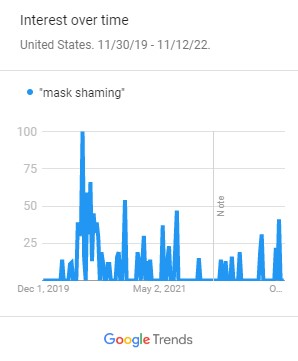
Sources:
boneritis69. Mask shaming meme. iFunny Brazil. 18 May 2020. URL: https://br.ifunny.co/meme/kMHPcjaf7.
CBS Sacramento channel. “Psychologist Explains Mask-Shaming During Pandemic.” YouTube. 2020. URL: https://www.youtube.com/watch?v=ONj98dtX88Y.
“Mash shaming.” Macmillan Dictionary. June 29, 2020. URL: https://www.macmillandictionary.com/us/dictionary/american/mask-shaming.
GD. “Mash shaming.” Urban Dictionary. April 4, 2020. URL: https://www.urbandictionary.com/define.php?term=Mask%20Shamed.
McSweeney, Terry. “‘Mask Shaming’ Becomes New Topic of Discussion During Fight Against COVID-19.” NBCBayArea.com. May 7, 2020. URL: https://www.nbcbayarea.com/news/coronavirus/mask-shaming-becomes-new-topic-of-discussion-during-fight-against-covid-19/2285899/.
Smith, Allan. “Stop Employees from ‘Mask Shaming’ Colleagues.” SHRM.org. April 4, 2022. URL: https://www.shrm.org/resourcesandtools/legal-and-compliance/employment-law/pages/stop-mask-shaming.aspx.
Coronageddon is a portmanteau of Armaggedon and Corona and refers to the end-times condition created by the rapid spread of Covid-19, mass hospitalizations and coronavirus deaths, huge job losses, lockdowns, quarantine and various other restrictions, not to mention constant news feed about the pandemic.
The Urban Dictionary has an entry for Coronageddon which was added on March 13, 2020:
“The near-certain, end-of-times condition created either by the actual COVID-19 virus or the massive social, financial and political devastation generated on the back of global hysteria” (YAWA).
Credit for the term must go to Bob Greer, a senior advisor for Core Commodity Management. According to a LinkedIn post he made on March 11, 2020, Bob dreamed up the term “coronageddon” in February 2020:
Living in Southern California has given our media more than one “..geddon” to talk about, regarding traffic, wildfires, etc. But I haven’t seen any referent anywhere to “coronageddon,” a term I dreamed up a couple of weeks ago. Maybe you will be able to use it (unfortunately) in your discussions or communications.
Greer
The term appeared in the Visual Thesaurus in an article entitled “New Virus, New Words.” Author Nancy Friedman says: “Since the COVID-19 pandemic began its lethal spread in December 2019, people all over the world have been adopting new behaviors and new vocabulary…Here are some of the new terms — call them coronacoinages or coronanovelties, in honor of the novel coronavirus that causes COVID-19 — that I’ve been tracking over the last few weeks.”
The end of the world, brought about either by the pandemic or by related social and economic collapse. Often used facetiously. Previous such portmanteaus have included snowmageddon and carmageddon; the 55-hour shutdown in 2016 of a freeway through the town of Corona, in Southern California, was also dubbed Coronageddon.
Visual Thesaurus
Coronageddon appears in a news article on the The Truth About Watches website. After discussing the fall in Swiss watch sales, job losses and shorter employee hours, author Joseph Adamas laments that this may be the “beginning of the end for the traditional watch industry…Nine months into Coronageddon and we still don’t know how things are going to play out. The pandemic’s effects continue to shift. Two months ago, the Europeans were happy to lecture us on how their superior system managed the pandemic. Today, Paris is going back into lockdown. The uncertainty makes it very hard for companies to plan for their future and makes predictions almost worthless.”
Here is one person’s take on Coronageddon during 2020. It’s quite funny and I recommend watching it.
It’s important to acknowledge that coronageddon fears were not overblown. No one could have foreseen a two week lockdown in the United States turning into a two year nightmare. As the pandemic becomes endemic and the pubic health emergency in the United States is scheduled to end in January 2023 it is hopeful that humanity can put this once in a century event behind us and move forwards.

Social Media Trends as of October 31, 2022
Facebook #coronageddon: 1,600 people are posting about this
Instagram #coronageddon: 8,929 posts
TikTok #coronageddon: 219,100 views
Google Trends: coronageddon first appeared in December 2019 when Covid-19 was first spreading in China. It reached its peak during the first week of December 2020.
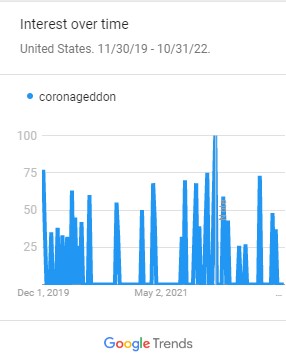
Sources:
Adams, Jospeh. “The Decline and Fall of the Traditional Watch Industry – Coronageddon 38.” The Truth About Watches. October 10, 2020. URL: https://thetruthaboutwatches.com/2020/10/the-decline-and-fall-of-the-traditional-watch-industry-coronageddon-38/.
Friedman, Nancy. “New Virus, New Words.” Visual Thesaurus. March 30, 2020. URL: https://www.visualthesaurus.com/cm/wordroutes/new-virus-new-words/.
Greer, Bob. “Coronageddon.” LinkedIn. March 11, 2020. URL: https://www.linkedin.com/pulse/coronageddon-bob-greer/?articleId=6643383753479634944.
Meme. “Coronageddon” meme. Meme. URL: https://me.me/i/armageddon-but-its-the-coronavirus-3e3212a33732412a9b932e9eae84ae49.
Mosley, Jordan channel. “Coronageddon: Expectations vs. Reality.” YouTube. 2020. URL: https://www.youtube.com/watch?v=D9o00OhW27E.
YAWA. “Coronageddon.” Urban Dictionary. March 13, 2020. URL: https://www.urbandictionary.com/define.php?term=Coronageddon.